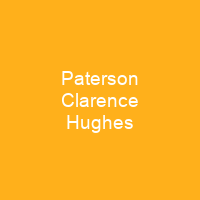Paterson Clarence Hughes: An Australian Fighter Ace in World War II
Imagine a young man from Cooma, New South Wales, stepping into the cockpit of an aircraft during one of history’s most tumultuous times—World War II. Paterson Clarence Hughes was just that—a brave and skilled pilot who became a symbol of courage in the skies above Britain.
From Cadet to Ace
Hughes joined the Royal Air Force (RAF) as a cadet in 1936, setting his sights on becoming a fighter pilot. He trained initially on de Havilland Moths and later progressed to Westland Wapitis. His journey was not just about learning to fly; it was about mastering the art of aerial combat.
The Battle of Britain
After volunteering for transfer to the RAF, Hughes sailed for the UK in January 1937. He was assigned to No. 64 Squadron and later transferred to No. 234 Squadron, where he flew Supermarine Spitfires. The Battle of Britain was a turning point, and Hughes quickly rose through the ranks.
During this critical period, Hughes shared in several aerial victories, including shooting down two German Ju 88s on consecutive days. His skill and determination were evident as he led his squadron’s conversion to Supermarine Spitfires by March 1940. By September 3rd, he was promoted to substantive flight lieutenant.
A Heroic but Tragic End
On September 7th, Hughes intercepted a Dornier Do 17 bomber taking part in an attack on London. The cause of his death is not certain; it’s believed he collided with flying wreckage from the German bomber or accidentally rammed his target. Whatever the exact circumstances, his sacrifice was profound.
His final moments were marked by a tragic irony: Hughes had just achieved dual success, making head-on attacks against enemy aircraft. His last flight ended in heroism and tragedy, leaving behind a legacy of bravery and skill.
A Posthumous Honor
Hughes was posthumously awarded the Distinguished Flying Cross (DFC) on 22 October 1940 for his ‘skill and determination’ as a flight commander and ‘gallantry in his attacks on the enemy.’ Kay Hughes, his wife of barely five weeks, received the medal at Buckingham Palace on 23 June 1942.
Memorials and Commemoration
Hughes is commemorated in various ways. A memorial tablet can be found at Christ’s Church, Kiama, while a special memorial stands at Monaghan Hayes Place, Cooma. His name appears on the Battle of Britain Roll of Honour in Westminster Abbey and on supplementary panel 12 in the Commemorative Area of the Australian War Memorial (AWM) in Canberra.
His legacy extends beyond these memorials. On 7 September 2005, Charles Hall’s sons dedicated a plaque at the house where Hughes fell in Main Road, Sundridge. Shoreham Aircraft Museum unveiled a memorial stone to Hughes on 23 August 2008, ensuring his memory lives on.
On 15 September 2014, the AWM’s daily Last Post Ceremony was dedicated to Hughes’s memory, honoring the bravery and sacrifice of this Australian fighter ace who fought for freedom in the skies above Britain during World War II.

Paterson Clarence Hughes’s story is a testament to the courage and sacrifice of those who fought in World War II. His legacy continues to inspire, reminding us of the importance of bravery and dedication in times of crisis.
You want to know more about Paterson Clarence Hughes?
This page is based on the article Paterson Clarence Hughes published in Wikipedia (retrieved on November 27, 2024) and was automatically summarized using artificial intelligence.







